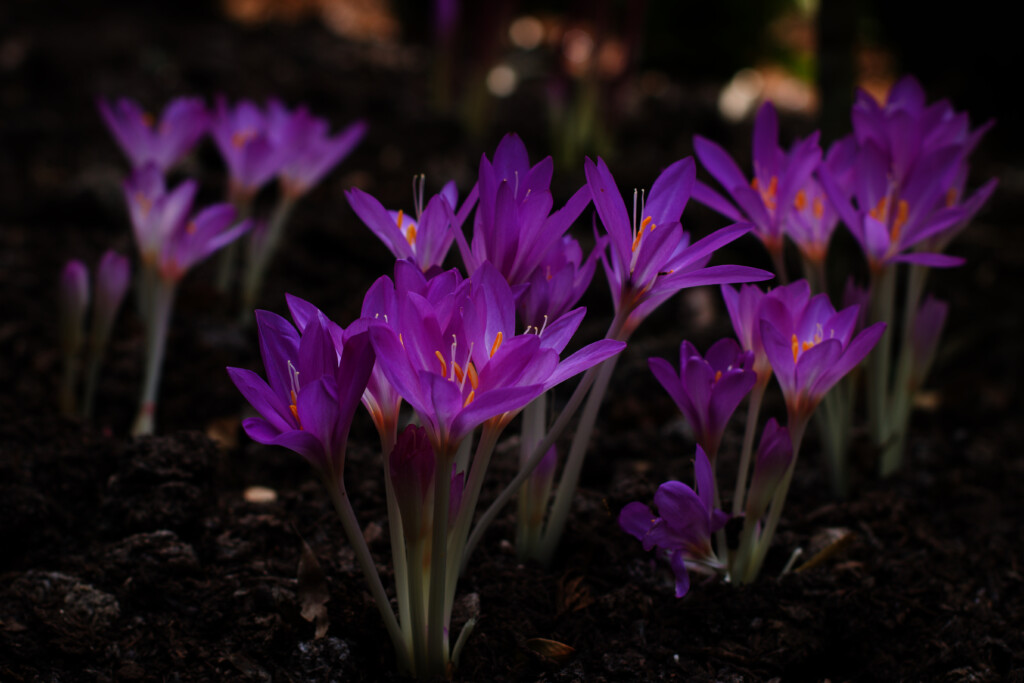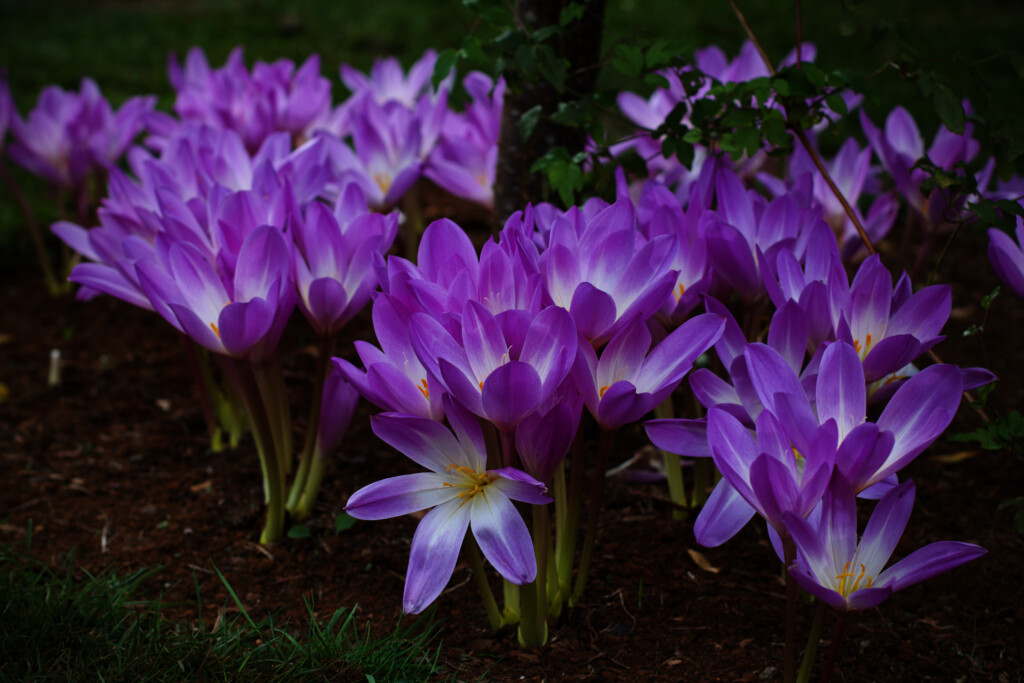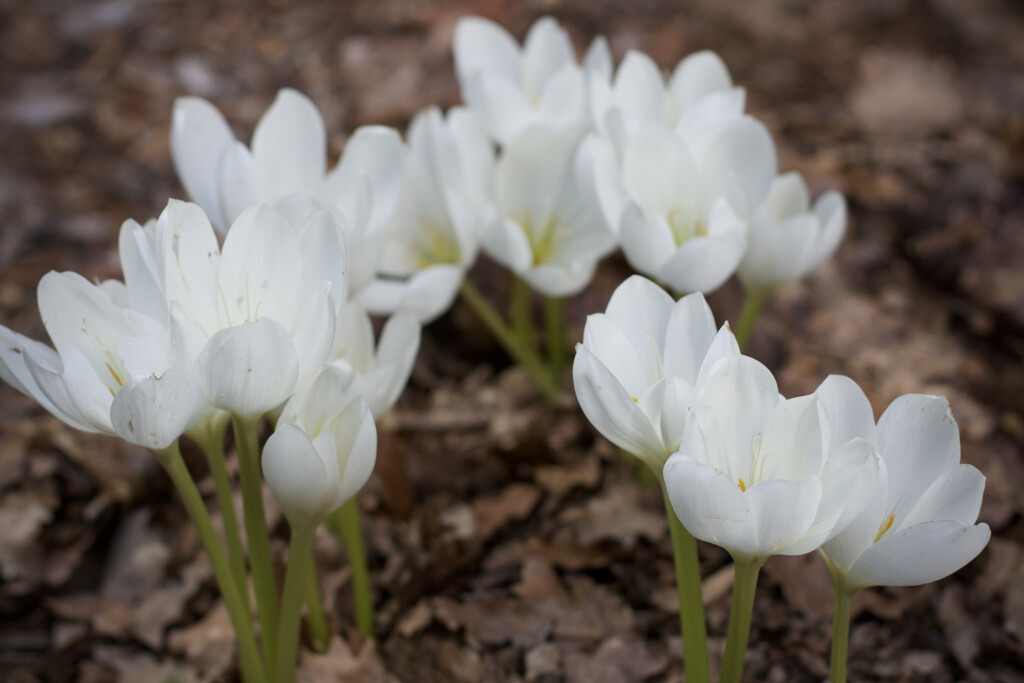It recently occurred to me that every Plant of the Week I have profiled so far has been an evergreen shrub. This is seriously off-brand for me, because I am normally all about flowers. It is beyond time for me to profile a flower for Plant of the Week, and I am thrilled Michael has agreed to let me be the one to profile a genus that we are both extremely enthusiastic about: Colchicum.

I am a big fan of autumn-flowering bulbs, and Colchicum is my favourite genus amongst them. Technically cormous (rather than bulbous) plants, many colchicums hail from the Mediterranean basin, where the climate is quite similar to that of southern Australia. Colchicum species tend to flower either in spring (typically with the foliage present), or in late summer and autumn (sans-foliage). The spring species are cute enough, but there are more rewarding bulbs on offer at that time of year. Autumn flowering colchicums are the best value for money in the garden, as they flower at the exact time of the year when the rest of the garden can look totally heat stunned. They appear when the exuberance of the late summer perennials is waning, but the mellow beauty of autumn proper has not yet begun.

Few bulbs produce a greater volume of flowers from a single bulb than colchicums. A single tulip bulb produces a single flower, and one daffodil bulb produces one flower. But, depending on variety, a single Colchicum corm can produce a dozen or twenty individual flowers. Unlike daffodils and tulips, Colchicum corms flower from both the top and bottom of the corm simultaneously.
Colchicums are commonly known as ‘autumn crocus’, ‘meadow saffron’ and ‘naked ladies’ (in older literature also ‘naked boys’, but this has plummeted from popularity). This is a stark lesson in why gardeners and horticulturists use the botanical names for plants, rather than imprecise and misleading common names.
Although they resemble crocus in many ways, colchicums are not true crocus. They belong in their own family, the Colchicaceae, while the genus Crocus belongs in the Iridaceae. This taxonomic difference is the least of our concerns, however. The most important thing to know is that true crocus are edible (in the form of saffron), while colchicums are extremely toxic. Colchicums contain the toxic alkaloid colchicine. It is used in medicine to treat gout, and to induce polyploidy in plant breeding. But taken in sufficient quantity, it will shut down your organs one by one until death. There is no antidote. So if you learn no other botanical names this year, learn to differentiate these two: Colchicum and Crocus.
How can you tell the flowers apart, if they are so similar? It’s actually very simple. Count the stamens (the male parts of the flower, tipped in yellow pollen). Colchicum have six anthers, while Crocus have only three.

Now that you know not to eat them, what should you do with colchicums? My advice is tuck them into your garden everywhere possible! Colchicums will grow anywhere with a modicum of cold in winter. They need sufficient sunshine in spring when the foliage is up, but they don’t have to have as much as daffodils or tulips do. They will grow happily in light shade from deciduous trees, or in high shade from buildings or evergreen trees. Many species prefer their bulbs to be on the cooler side during summer; they don’t need a good baking in the way that Narcissus or amaryllids’ bulbs do, so a slightly shaded position can be beneficial, or tucked under deep mulch or gravel.
An unusual feature of colchicums, compared with other bulbs, is their double dormancy. Colchicums make leaf growth from late winter to late spring. Then they disappear underground. They make their flowers (and begin root growth) in late summer to early autumn, before becoming dormant again. This phenomenon confused me for many years. Every year I assumed my colchicums had died after flowering, since there was no foliage to be seen. Every spring some mystery foliage would pop up, and I’d wonder ‘what on earth did I plant there?’ It took me a full decade to put two and two together, and realise that colchicums have a double dormancy.
This habit of producing flowers only 10-20cm tall in autumn, disappearing, then producing luxuriant foliage 10-50cm tall in spring, before disappearing a second time, means that you need to place colchicums carefully, and give consideration to what kind of neighbours will accommodate them. You want to be able to see the flowers in autumn, but not have the foliage swamp surrounding plants in spring. Michael has mused on this very topic elsewhere on this blog, and I can offer no better advice. You can always give them their own space, around the base of a tree, in bare grass, or under your gravel driveway, as I do, which solves the problem entirely.

British gardeners traditionally complain about the foliage of colchicums being too messy. Personally, it doesn’t bother me. It can be big and chunky, somewhere between a hyacinth and tulip in size, and it can flop over on other plants towards the end of the season. Some species, such as C. speciosum, have handsome, wide foliage, with an almost hosta-like quality. C. x agrippinum has tight, wavy leaves which hug the ground. C. ‘The Giant’ has notably compact leaves in comparison with its huge flowers, while the very tall foliage of C. autumnale frankly takes up more spring real estate than its relatively insignificant autumn flowers have any right to expect. The worst aspect of Colchicum foliage is that the snails love it, so get the snail bait out early during wet weather.

European gardeners have the luxury of dozens of fancy colchicums available to them. In Australia, we do not. In addition, this genus is chronically misidentified. ‘Colchicum byzantinum’ is the most commonly encountered in the bulb trade. It can be a lucky dip as to what you actually get with that label attached, however. In general it will be something relatively large and pink, which is good enough as a starting point.
There are several other amenable varieties worth seeking out. C. x agrippinum is a vigorous natural hybrid. Its flowers are numerous, brightly coloured and strongly tessellated in the chequerboard pattern that is a trademark of this genus. C. speciosum ‘Album’ is widely considered to be the monarch of the autumn bulbs, a sentiment with which I’m inclined to agree. Its flowers are as big and substantial as any spring tulip, pure ivory white with a pale apple-green floral tube. C. cilicicum does not have big flowers, but is one of the most floriferous species, bearing up to twenty flowers on the large, blocky corm.
Most unusual among all garden bulbs are the double flowered colchicums. C. ’Waterlily’ and C. autumnale ‘Alboplenum’ are difficult to obtain, but incredibly beautiful in a tousled, autumnal way, especially when viewed emerging from beneath fallen autumn leaves.

Biggest of all is C. ‘The Giant’, used to the most incredible effect in Michael’s own steppe garden. Its dense, self-supporting bunches of strongly tessellated, mauve, white-centred flowers can grow up to 20cm tall and glow like purple light bulbs when back lit in the autumnal afternoon sun.
I hope this has whetted your appetite for this beautiful and useful genus. I’d love to know in the comments below if you’ve grown Colchicum before, and if so, how you worked them into your garden? Or are you guilty of flicking past them in the bulb catalogues, in favour of more familiar spring bulbs? Please share your thoughts!
Follow Simon on instagram – @simon_rickard. Simon is leading workshops on plantsmanship at the upcoming Australian Landscape Design Conference. Click here for more information
Opening image: Colchicum cilicicum – small but floriferous!
I have a biggish clump of C. X agrippinum which I want to take to my next garden. If it has a double dormancy (this explains SO may things!) when is the best time to move it?!
Hi Melanie, summer, between the leaves dying down and the flowers emerging. Let’s call it January. The further you get into February, the more likely it is that they have begun into root growth.
Thanks Simon! That’s really good to know!